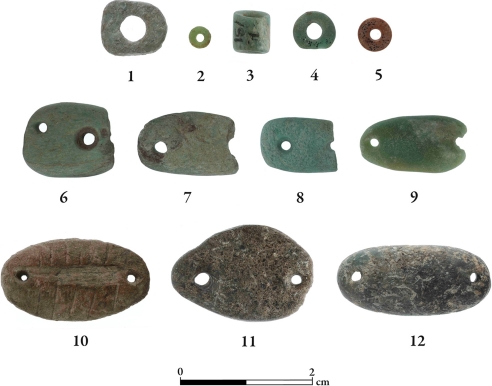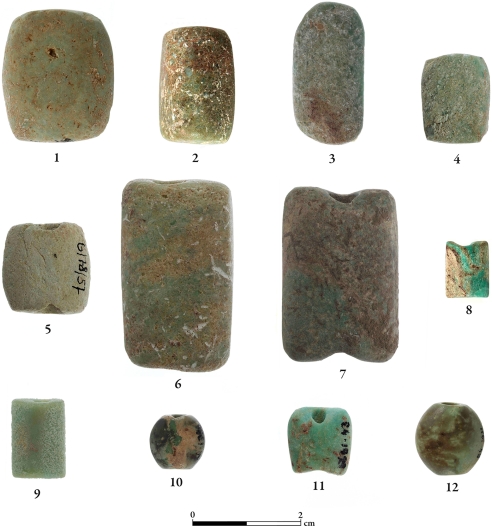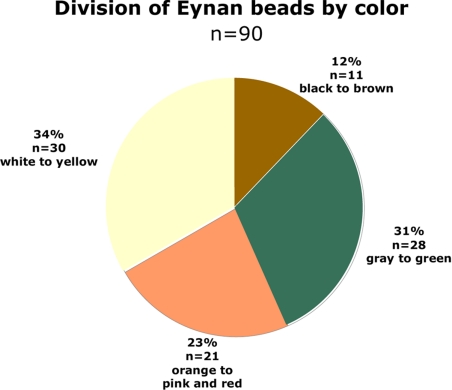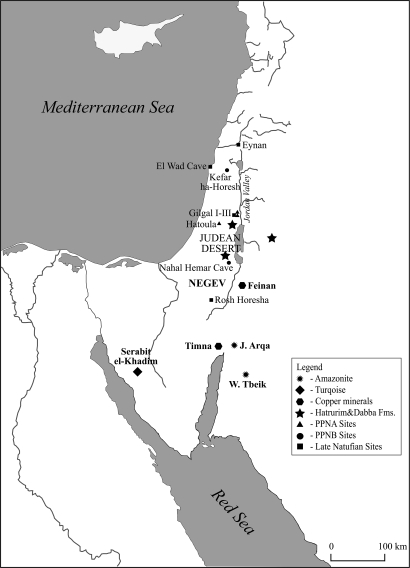Abstract
The use of beads and other personal ornaments is a trait of modern human behavior. During the Middle and Upper Paleolithic periods, beads were made out of shell, bone, ivory, egg shell, and occasionally of minerals. During the transition to agriculture in the Near East, stone, in particular green stone, was used for the first time to make beads and pendants. We observed that a large variety of minerals of green colors were sought, including apatite, several copper-bearing minerals, amazonite and serpentinite. There seems to be an increase with time of distance from which the green minerals were sought. Because beads in white, red, yellow, brown, and black colors had been used previously, we suggest that the occurrence of green beads is directly related to the onset of agriculture. Green beads and bead blanks were used as amulets to ward off the evil eye and as fertility charms.
Keywords: transition to agriculture, late Natufian, Neolithic, Near East, symbolism
The use of beads is an expression of behavior unique to Homo sapiens, and the earliest known beads, associated with early modern humans, were made of mollusk shells. They were discovered in the Middle Paleolithic sites of Skhul Cave in Israel dating to ≈110 ka (1–3); Qafzeh Cave, Israel, ≈92 ka (4); Grotte des Pigeons, Morocco, ≈82 ka (5); and Blombos Cave, South Africa, ≈77 ka (6).
An increase in the variability of raw materials emerges during the Upper Paleolithic age, mainly in Europe but also in Africa and Asia, when beads were made of bone, teeth, antler, ivory, and ostrich egg shells, all of biological origin (e.g., 7, 8). Few beads made of steatite and other rocks and minerals were found in Upper Paleolithic sites in Europe (7, 9), all within the social context of foragers. The color of these artifacts is significant and is usually in different hues of white, yellow, brown, red, and black with a few isolated cases of green steatite (9).
A major change occurred during the transition from hunting and gathering to agriculture in the Near East. This period spans the transition from the Pleistocene to the Holocene era, and culturally it marks the passage from the last Epi-Paleolithic culture, namely the Natufian, to Neolithic cultures. The latter periods have been characterized as to their material culture, specifically lithic artifacts, ground stone tools, and shell and bone artifacts. The faunal and floral remains and the physical anthropology of human remains were also studied extensively (e.g., 10–12 and references therein). Stone beads, though, have not been studied in a comprehensive way and were only examined on a per site basis (e.g., 13–16). The only exception to this is a study of later Neolithic stone beads and raw materials from Jordan (17).
The first appearance of stone beads in the Levant is in the Late Natufian [≈13,000–11,500 calibrated (cal) B.P.]. Their green color is what distinguishes them from all other beads and pendants previously discovered. A few beads were reported by Beck (18) from el-Wad Cave in Mount Carmel; however, Garrod, who excavated the site, questioned their stratigraphic position and doubted this early age (1). Our study reexamines most stone beads from excavations in Israel dating to Natufian and Neolithic cultures that were excavated over the last 30 years. This comprehensive and systematic project aims to understand better the use of beads by studying typological, technological, and mineralogical aspects. This report addresses primarily the mineralogical aspects thus far obtained.
Beads.
To date, we studied 221 beads from eight sites (Table 1), dating to the Late Natufian, Pre-Pottery Neolithic A (PPNA; 11,600–10,500 cal B.P.), and Pre-Pottery Neolithic B (PPNB; 10,500–8,200 cal B.P.). For each bead or pendant, we recorded size, weight, color, raw material, typology [tentatively based on Beck's typology (19)], and the archaeological location and context in which it was discovered. Raw material definition was based on tests and observation under binocular microscope with magnification of ×10–×40. Attention was paid especially to fabric (grain size and shape), effervescence with 3% HCl, and hardness (using a stainless steel pin equivalent to 6 on the Mohs scale). Representative beads were further analyzed by scanning electron microscope equipped with an energy dispersive spectrometer and by x-ray diffraction.
Table 1.
Green beads in Late Natufian and Pre-Pottery Neolithic sites in Israel
| Site | Ref. | No. stone beads | Green beads,% | Apatite* | Fluorapatite† | Chrysocolla‡ | Malachite§ | Turquoise¶ | Amazonite‖ | Serpentinite** |
|---|---|---|---|---|---|---|---|---|---|---|
| Late Natufian | ||||||||||
| Rosh Horesha | 39 | 5 | 80 | + | ||||||
| Eynan | 40 | 90 | 28 | + | + | +? | +? | |||
| Gilgal II | 36 | 18 | 66 | + | + | |||||
| El Wad | Israel Museum | 3 | 100 | + | ||||||
| PPNA | ||||||||||
| Hatoula | 41 | 49 | 47 | + | + | + | + | + | ||
| Gilgal I | 36 | 3 | 66 | + | ||||||
| Gilgal III | 36 | 5 | 80 | + | + | |||||
| PPNB | ||||||||||
| Kefar ha-Horesh | This study | 48 | 33 | + | + | + | + | + |
Beads refer also to bead blanks and pendants but not to chunks of raw material discovered in some of the sites. +, identified; +?, tentative identification.
*Ca5(PO4)3OH from Dabba or Hatrurim Formation.
†(CaF)Ca4(PO4)3OH from Dabba or Hatrurim Formation.
‡CuSiO3·2H2O from Faynan, Timna, or Sinai.
§CuCo3·Cu(OH)2 from Faynan, Timna, or Sinai.
¶CuAl6(PO4)4(OH)8·4H2O from Sinai.
‖KAlSi3O8 from Saudi Arabia.
**(Mg,Fe)3Si2O5(OH)4 from North Syria or Cyprus.
Typologically, the bead shapes of these periods include a round “disk bead,” whereby the height of the bead is less than one-third of its diameter (Fig. 1, beads 1, 2, 4, and 5), as well as oval pendant with two holes (one at each end) (Fig. 1, pendants 6–12), long and short cylindrical beads (Fig. 1, bead 3; Fig. 2, beads 5–9), and cylindrical bead blanks (that have not been perforated; Fig. 2, items 1–4). Of special interest are the oval double-holed pendants that are found only in Late Natufian and early PPNA sites and can serve as a chronological marker. A detailed typological and technological analysis will be published elsewhere (unpublished data).
Fig. 1.
Beads and pendants from Gilgal II (Late Natufian). Disk beads are numbered 1, 2, 4, and 5; a short cylinder bead is labeled with the number 3; and the double-holed pendants are numbers 6–12.
Fig. 2.
Cylindrical beads and bead “blanks.” Unperforated cylinders (numbered 1–4) from Gilgal I and III (PPNA); cylindrical beads (numbered 5 and 8) from Gilgal I and III (PPNA); cylindrical beads (numbered 6, 7, and 9) from Hatoula (PPNA); and standard cylinders (numbered 10–12) from Nahal Hemar Cave (PPNB).
The beads' colors were described in detail, and then divided into four main groups: white to pale yellow, black to brown, orange to red, and gray to green. White, brown, yellow, red, and black beads made of shell, bone, teeth, ivory, ostrich egg shell, and amber, all of biological origin, as well as steatite, ochre, and hematite, which are inorganic materials, have been known from the Middle and Upper Paleolithic (7, 20). However, green minerals are found for the first time in significant numbers, in the context of archaeological entities that bear evidence of being in the midst of an economic change in subsistence strategy, the beginning of cultivation.
In all of the sites studied thus far, beads of white and red limestone, quartzite, ochre, basalt, and clay, as well as shell were present. Most sites contained also beads made of apatite, fluorapatite, malachite, chrysocolla, turquoise, amazonite, and serpentinite, minerals that are in various shades of green, and appear for the first time in the archaeological record of the Near East during the periods discussed here (Fig. 3). Table 1 summarizes the green stone beads of the Late Natufian, PPNA, and PPNB sites.
Fig. 3.
Color distribution of beads from Eynan.
None of these green minerals is found in the immediate vicinity of any of the sites studied. Apatite and fluorapatite are assumed to originate in the Dabba marbles of Jordan or in the Hatrurim Formation of Israel (ref. 21 and Fig. 4). Major exposures of the Hatrurim Formation are located on the shoulders of the Jordan Rift Valley, in the Judean Desert, and the NE Negev. The sources of chrysocolla and malachite could be in the Faynan or Timna copper mine areas, whereas turquoise may have been obtained in the Sinai copper mines near Serabit el Khadem. The closest source of amazonite can be found in Wadi Tbeik in Saudi Arabia, 150 km south of Jebel Arqa (ref. 22 and Francesco Berna, personal communication), and serpentinite would have to be brought from either northern Syria or Cyprus. The three sites of Gilgal are within a 15-km distance from the nearest exposure of the Hatrurim Formation (Fig. 1), but other sites, such as Eynan, are >100 km away from that nearest source.
Fig. 4.
Location map showing the Natufian to Neolithic sites mentioned in the text and known sources for green beads. The amazonite workshop at Jebel Arqa is of PPNB age. Copper minerals are mainly silicates (chrysocolla) and carbonates (malachite). Turquoise is known only from Serabit el-Khadim. Apatite comes from the Hatrurim and Dabba Formations in Israel and Jordan, respectively. Only the major outcrops of these formations are shown.
In this work we characterized as many attributes of the beads as possible. In the following discussion we attempt to explain why green stone beads, never before encountered in the Near East, emerge along with the emergence of agriculture.
Discussion
The earliest cultivators at the end of the Natufian and the PPNA farmers made great efforts at obtaining green minerals for the production of beads and pendants, and in the PPNB this trend expands: A larger variety of raw materials is sought after, from more sources (Table 1 and Fig. 3). We propose that the green color mimics the green of young leaf blades, which signify germination and embody the wish for successful crops and for success in fertility.
The use of green and blue beads is encountered in all archaeological periods that follow the Neolithic, and recent ethnographic studies clarify their meanings. Ethnographic studies supply ample evidence for the significance of beads and pendants as artifacts with symbolic meaning (e.g., 23–26). The meanings of beads are far and wide and consist of beliefs intended “to prevent misfortune and danger, to counteract or divert the effects of supernatural powers, and to bring luck and strength” (25). Many of these beliefs existed well before the agricultural revolution and were expressed in symbolic behaviors as early as the Middle Paleolithic era (e.g., 27, 28). However, the onset of agricultural practices brings with it a special interest in fertility both of plants and animals and of humans. This interest, in turn, brought on a change in human demography caused by higher birth rates and a greater rate of deaths after child delivery, in addition to other ailments (29–31). This increase in health problems required new means of coping. It is likely that medicinal plants were used for curing some of the conditions, but symbolic practices and the use of apotropaic artifacts undoubtedly complemented the plant treatment. It is likely that the same green beads that were “in charge” of improving crops were also responsible for keeping the well being of the farmers that raised these crops.
The use of green beads is an ongoing tradition in the Near East. Green and/or blue beads were encountered in all periods up to recent historic periods. Blue “eyes” are produced in Turkey and elsewhere to this day. Their association with agricultural practices requires further study; however, a study of heirloom jewelry in a farming community in Jordan during the past century emphasizes the beads' amuletic use, and in particular their relevance to women's health and fertility, which are considered by the owners to be the result of the “evil eye's” power (24). This notion is reinforced by other studies concerned with the meaning of beads. In particular, in Zulu, linguistically, only black, white, and red are nonreferential colors, whereas other colors derive etymologically from and refer to plants, animals, or other natural objects (26). In Hebrew, too, the word for green and the word for vegetable share the same root. In the Zulu tribes studied by Morris and Preston-Whyte “Older beadmakers tend to agree that in general terms white beads stand for purity and perhaps innocence, black for depth and profundity, while light blue beads indicate ripeness and fertility” (25). One should note that green and blue beads are interchanged in different cultures and especially in ancient Egypt (32).
Yet another aspect that may shed light on the symbolism attributed to green stone beads is the double-holed oval pendants. Some of them are green and others brown to black, but all were made of fluorapatite that probably originated in the Hatrurim Formation. One of them (Fig. 1, pendant 10) has a deep incision between its two holes and smaller incisions perpendicular to it, possibly imitating cowrie shells, the latter known to serve as fertility amulets in many different cultures (e.g., 33, 34). Double-holed oval pendants from predynastic Egypt are also considered to imitate cowries (35). Interestingly, a number of such pendants were found at Gilgal (36) where real cowrie shells, although present in other Natufian and PPNA sites (2), are absent.
In 1930, Budge wrote that “green stones, e.g., nephrite, the emerald, green jade, Amazon stones, etc., are connected with luxuriant vegetation and the rain that causes it, and fertility in man and beast, and virility and strength generally” (37). Our study provides archaeological evidence for the emergence of these beliefs. To conclude, the occurrence of green stone beads is highly associated with the transition to agriculture and may signify the first use of this color to ward off the “evil eye” that is mentioned already in Mesopotamian texts (38 and references therein). This tradition may have begun in the Near East as early as 10,000 years ago.
Acknowledgments.
Thanks to all archaeologists who provided the beads to be studied: O. Bar-Yosef (Harvard University, Boston), Y. Garfinkel (Hebrew University of Jerusalem, Jerusalem), A. Gopher (Tel-Aviv University, Ramat Aviv, Israel), A. N. Goring-Morris (Hebrew University of Jerusalem), H. Khalaily (Israel Antiquities Authority), A. Ronen (University of Haifa, Haifa, Israel), F. R. Valla (Centre National de la Recherche Scientifique, Paris), and M. Weinstein-Evron (University of Haifa). In addition, we thank Natalia Gubenko, Mikki Sebbanne, and Hava Katz of Israel Antiquities Authority for enabling the restudy of the beads of Hatoula; Debby Hershmann enabled the study of beads at the Israel Museum. We thank M. Dvorachek at the Geoogical Survey of Israel for the SEM analyses and Tamar Zewi (University of Haifa) for linguistic advice. Francesco Berna (Boston University) provided information on amazonite sources. Yvonne Markowitz (Boston Museum of Fine Arts) was consulted regarding Egyptian amulets. Dan'el Kahn (University of Haifa) and Piotr Steinkeller (Harvard University) advised us on the evil eye in ancient texts. Finally, we thank Nigel Goring-Morris, Leore Grosman, Debby Hershmann, Avraham Ronen, François Valla, Mina Weinstein-Evron, Ofer Bar-Yosef, and an anonymous reviewer for useful comments on previous drafts. This work was supported by Israel Science Foundation Grant 62/05 and by the American School of Prehistoric Research at the Peabody Museum, Harvard University.
Footnotes
The authors declare no conflict of interest.
This article is a PNAS Direct Submission.
References
- 1.Garrod DAE, Bate DMA. The Stone Age of Mount Carmel. Oxford: Clarendon; 1937. [Google Scholar]
- 2.Bar-Yosef Mayer DE. The exploitation of shells as beads in the Palaeolithic and Neolithic of the Levant. Paléorient. 2005;31:176–185. [Google Scholar]
- 3.Vanhaeren M, et al. Middle Paleolithic shell beads in Israel and Algeria. Science. 2006;312:1785–1788. doi: 10.1126/science.1128139. [DOI] [PubMed] [Google Scholar]
- 4.Taborin Y. In: Échanges et Diffusion dans la Préhistoire Méditerranéenne. Vandermeersch B, editor. Paris: Editions du Comité des Travaux Historiques et Scientifiques; 2003. pp. 113–122. [Google Scholar]
- 5.Bouzouggar A, et al. 82,000-year-old shell beads from north Africa and implications for the origins of modern human behavior. Proc Natl Acad Sci USA. 2007;104:9964–9969. doi: 10.1073/pnas.0703877104. [DOI] [PMC free article] [PubMed] [Google Scholar]
- 6.Henshilwood CS, d'Errico F, Vanhaeren M, van Niekerk K, Jacobs Z. Middle stone age shell beads from South Africa. Science. 2004;304:404. doi: 10.1126/science.1095905. [DOI] [PubMed] [Google Scholar]
- 7.White R. In: Before Lascaux: The Complex Record of the Early Upper Paleolithic. Knecht H, Pike-Tay A, White R, editors. Boca Raton, FL: CRC; 1993. pp. 277–299. [Google Scholar]
- 8.Ambrose SH. Chronology of the later stone age and food production in east Africa. J Archaeol Sci. 1998;25:377–392. [Google Scholar]
- 9.Taborin Y. Language sans Parole: La Parure aux Temps Préhistoriques. France: La Maison des Roches; 2004. [Google Scholar]
- 10.Bar-Yosef O, Meadow RH. In: Last Hunters, First Farmers: New Perspectives on the Prehistoric Transition to Agriculture. Price TD, Gebauer AB, editors. Santa Fe, NM: School of American Research Press; 1995. pp. 39–94. [Google Scholar]
- 11.Kuijt I, editor. Life in Neolithic farming communities: Social organization, identity, and differentiation. New York: Kluwer; 2000. [Google Scholar]
- 12.Eshed V, Gopher A, Gage TB, Hershkovitz I. Has the transition to agriculture reshaped the demographic structure of prehistoric populations? New evidence from the Levant. Am J Phys Anthropol. 2004;124:315–329. doi: 10.1002/ajpa.10332. [DOI] [PubMed] [Google Scholar]
- 13.Wheeler M. In: Excavations at Jericho V. Kenyon KM, Holland TA, editors. Jerusalem: British School of Archaeology; 1983. pp. 781–787. [Google Scholar]
- 14.Moholy-Nagy H. In: Prehistoric Archeology along the Zagros Flanks. Braidwood LS, Braidwood RJ, Howe B, Reed CA, Watson PJ, editors. Chicago: Oriental Institute; 1983. pp. 289–346. [Google Scholar]
- 15.Hauptmann A. In: Basta I: The Human Ecology. Nissen HJ, Muheisen M, Gebel HGK, editors. Berlin: Ex Oriente; 2004. pp. 169–176. [Google Scholar]
- 16.Maréchal C. In: Aswad et Ghoraifé. de Contenson H, editor. Beyrouth: Institut Français d'Archéologie du Proche Orient; 1995. pp. 129–162. [Google Scholar]
- 17.Wright K, Garrard A. Social identities and the expansion of stone bead-making in Neolithic Western Asia: New evidence from Jordan. Antiquity. 2003;77:267–284. [Google Scholar]
- 18.Beck H. The Stone Age of Mt. In: Garrod DAE, Bate DMA, editors. Carmel. Oxford: Clarendon; 1937. p. 125. [Google Scholar]
- 19.Beck HC. Classification and nomenclature of beads and pendants. Archaeologia. 1928;Vol 1:1–76. 2nd series. [Google Scholar]
- 20.Peñalver E, Álvarez Fernández E, Arias P, Delclos X, Ontanon R. Local amber in a Paleolithic context in cantabrian Spain: The case of La Garma A. J Archaeol Sci. 2007;34:843–849. [Google Scholar]
- 21.Gross S. The Mineralogy of the Hatrurim Formation, Israel Geological Survey Bulletin 70. Jerusalem: Geological Survey of Israel; 1977. [Google Scholar]
- 22.Fabiano M, Berna F, Borzatti von Löwenstern E. Acts of the XIVth World Congress of the Union of Prehistoric and Protohistoric Sciences (UISPP); September 2–8, 2001; Liege (Belgium). 2004. pp. 265–275. ed Secretariat du Congres (BAR International Series) [Google Scholar]
- 23.Ao AS, Liu RK. Naga Tribal Adornment: Signatures of Status and Self. Washington, DC: Bead Society of Greater Washington; 2003. [Google Scholar]
- 24.Mershen B. Amulets and jewelry from Jordan: A study on the function and meaning of recent bead necklaces. Tribus. 1989;38:43–58. [Google Scholar]
- 25.Morris J, Preston-Whyte E. Speaking with Beads: Zulu Arts from Southern Africa. New York: Thames and Hudson; 1994. p. 55. [Google Scholar]
- 26.Wickler W, Seibt U. Syntax and semantics in a Zulu bead colour communication system. Anthropos. 1995;90:391–405. [Google Scholar]
- 27.Hovers E, Ilani S, Bar-Yosef O, Vandermeersch B. An early case of color symbolism: Ochre use by modern humans in Qafzeh cave. Curr Anthropol. 2003;44:491–522. [Google Scholar]
- 28.Leroi-Gourhan A. L'Art Pariétal: Langage de la Préhistoire. Grenoble: Jérome Millon; 1992. [Google Scholar]
- 29.Cohen MN, Armelagos GJ. Paleopathology at the Origins of Agriculture. New Haven: Yale Univ Press; 1984. [Google Scholar]
- 30.Bocquet-Appel JP. Palaeoanthropological traces of a Neolithic demographic transition. Curr Anthropol. 2002;43:637–650. [Google Scholar]
- 31.Smith P, Horwitz LK. In: Ancient Health: Skeletal Indicators of Agricultural and Economic Intensification. Cohen MN, Crane-Kramer GMM, editors. Gainesville: Univ Press of Florida; 2007. pp. 207–222. [Google Scholar]
- 32.Baines J. Color terminology and color classification: Ancient Egyptian color terminology and polychromy. Am Anthropol. 1985;87:282–297. [Google Scholar]
- 33.Jackson JW. Shells as Evidence of the Migration of Early Culture. Green, London: Longmans; 1917. pp. 123–194. [Google Scholar]
- 34.Choyke AM. In: Import and Imitation in Archaeology. Biehl PF, Rassamakin J, editors. Langenweissach: Beier & Beran; 2008. in press. [Google Scholar]
- 35.Andrews C. Amulets of Ancient Egypt. Austin: University of Texas Press; 1994. p. 71. [Google Scholar]
- 36.Bar-Yosef Mayer DE. In: Gilgal: Early Neolithic Occupations in the Lower Jordan Valley, The Excavations of Tamar Noy. Bar-Yosef O, Goring-Morris AN, Gopher A, editors. Boston: Brill; 2008. in press. [Google Scholar]
- 37.Budge EAW. Amulets and Superstitions. New York: Dover; 1978. p. 326. [Google Scholar]
- 38.Geller MJ. In: Literatur, Politik und Recht in Mesopotamien: Festschrift für Claus Wilcke. Sallaberger W, Volk K, Zgoll A, editors. Wiesbaden, Germany: Harrassowitz; 2003. pp. 117–131. [Google Scholar]
- 39.Larson PA. Ornamental beads from the Late Natufian of southern Israel. J Field Archaeol. 1978;5:120–121. [Google Scholar]
- 40.Valla FR, et al. Les fouilles de Ain Mallha (Eynan) de 2003 à 2005: Quatrième rapport préliminaire. J Israel Prehistoric Soc. 2007;37:135–383. [Google Scholar]
- 41.Lechevallier M. In: Le Gisement de Hatoula en Judée Occidentale, Israël. Lechevallier M, Ronen A, editors. Jerusalem: Centre de Recherche Français de Jérusalem; 1994. pp. 227–232. [Google Scholar]






